
Do you know?
The “Blue Danube waltz“ wasn’t an instant hit when Johann Strauss II first introduced it in 1867. It only became world-famous later, especially after it was featured in Stanley Kubrick’s classic film 2001: A Space Odyssey, where the graceful waltz plays during a spaceship docking scene. Since then, it’s been heard everywhere from New Year’s concerts in Vienna to TV shows and even modern series like Squid Game.
Do you want to bring a little Viennese sparkle to your piano playing? The “Blue Danube” piano waltz by Johann Strauss is one of those timeless melodies that everyone recognizes and the best part is you can start learning it today, even as a beginner.
With Skoove by your side, the Blue Danube waltz becomes more than just a song. In this tutorial, we’ll show you the easy piano notes, finger positions, and practice tips so you can play the famous theme without stress. By the end, you’ll be able to sit at the piano and let those swirling waltz notes dance off your fingertips, and when you’re ready, the interactive Skoove lesson will help you refine your timing and sound with real-time feedback.
“Blue Danube” piano notes
Let’s start with the melody that everyone knows. We’ll keep it simple with “Blue Danube” easy piano letter notes so you can follow along easily.

To make things clear, we’ll look at each hand separately, first the melody in the right hand, then the accompaniment in the left.
Playing the notes with the right hand
Let’s dive straight into the “Blue Danube” piano letter notes. We’ll start with the right hand notes, the part everyone recognizes.
Start with your thumb (finger 1) on C. Let your other fingers rest naturally on D (2), E (3), F (4), and G (5). This position covers the main notes of the theme.
C (1) – C (1) – E (3) – G (5) – G (5) – G (5) – G (5) – E (3) – E (3)

Great work! You’ve got the melody, let’s make it dance by adding the left hand.
Playing the notes with the left hand
Now let’s give this piano song its famous waltz rhythm. Your left hand will keep a steady “oom–pah–pah” pattern while your right hand sings the melody.
Place your pinky (finger 5) on the C below middle C, your middle finger (3) on E, and your thumb (1) on middle C. This simple hand shape sets you up for the classic waltz bass.
Here’s the basic pattern:
C (5) – C (5) – E (3) – G (1) – G (1)

How to play “Blue Danube” on piano?
Now that you know the right-hand melody and the left-hand accompaniment, it’s time to put them together. Start slowly, keeping the left hand steady in its “oom–pah–pah” waltz rhythm while the right hand plays the flowing melody on top. Don’t rush, even a slow waltz still sounds beautiful.
Watch the tutorial video below to see how both hands work together in real time. Follow along on your piano or keyboard and play each section as many times as you need before moving on.
“Blue Danube” practice tips
Learning the “Blue Danube” piano waltz is all about steady rhythm and smooth hand coordination. Here are a few tips to make your practice easier and more fun:
- Count out loud – Say “1–2–3” as you play to keep the waltz pulse steady, the pinky note is the strong oom and the two upper notes are the lighter pah-pah.
- Hands separate first – Practice the melody with your right hand alone, then the left-hand rhythm, before combining them.
- Loop tricky spots – Don’t always start from the beginning. Repeat the small parts where you stumble until they feel natural.
- Notice patterns – The first bar of the left hand is a C major arpeggio. Paying attention to patterns you have already practiced will make digesting new songs easier.
- Start slow, then speed up – Play at a comfortable pace. Once you can play smoothly, gradually increase the tempo.
Keep the music flowing
Mastering the “Blue Danube” piano song is just the beginning. With Skoove, you can keep building your skills by exploring hundreds of songs, from classical favorites to pop hits. Each lesson guides you step by step, so every new piece feels achievable. Start your next song today. Happy practicing!
Author of this blog post:
Matthew Dickman

With over a decade of experience in music education Matthew holds a BA in Music from Paul McCartney’s LIPA and an MA in Composition from the University of Salford. Mathew has developed a distinctive compositional voice and approach to music theory education through his research and work in the music industry. Matthew’s writing for Skoove combines experience from orchestral and media composition, and as a gigging jazz musician, to create a wholistic and accessible pedagogy for musicians of any level. Away from music, he enjoys reading and exploring nature to expand his horizons and knowledge contributing to his holistic teaching style.














